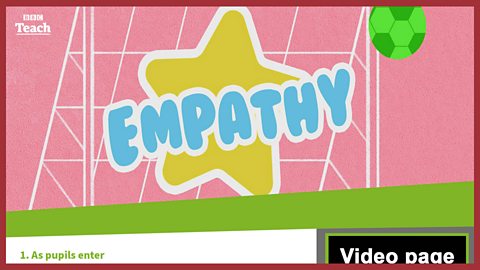In short...
Themes: Christianity; the parables of Jesus; empathy; understanding; Empathy Day.
Summary: This assembly, which is suitable for an act of collective worship, focuses on a story from the New Testament part of the Bible called тThe Good Samaritanт. A 'Samaritan' is someone from the ancient biblical region of Samaria. The assembly could be used to mark Empathy Day, which in 2024 falls on 6 June.
Resources: The ; an image to display ; have some photos to display of faces showing different emotions, or alternatively use the provided.

The video
GEMMA: Hello, Treasure Champs. I'm Gemma and we are here to tell you the story of The Good Samaritan.
Go on, you two, run ahead.
One day, a Jewish man was going on a journey.
He set off on a path. He was on his way to another town. But thenтІ It was going to be a long, hard journey.
It was a dangerous path known to have robbers and bandits. Uh-oh, the robbers spotted the traveller and decided to steal his things.
BOY: Agh!
ROBBER: Ha ha ha!
GEMMA: Ouch! The man was hurt and couldn't walk any further. He was left at the side of the path all alone. But then he saw someone coming. It was a religious man from the temple.
The traveller thought, 'This man must be good and kind and is sure to stop and help me.'
BOY: Help!
GEMMA: But the religious man didn't. In fact, he crossed over to the other side of the path and carried on walking by.
But then, along came another man, a man who was rich and important. So, once again, the traveller cried out for help.
BOY: Help me, please!
GEMMA: But he didn't stop to help either. He did nothing, he just carried on walking by on the other side of the path. The traveller was beginning to give up hope. Why was no one stopping to help him? But just thenтІ
Another man came along. 'Uh-oh,' thought the traveller, 'this man won't help me. I'm Jewish and he's a Samaritan. Jews and Samaritans don't like each other.'
But, to his surprise, the Samaritan did stop to help. He could see that the traveller was hurt and decided to help him. The Samaritan had empathy for the traveller. He thought how horrible it must have been to be attacked and left on the path.
SAMARITAN: Okay?
GEMMA: The Samaritan washed and bandaged the injured traveller and then they both set off looking for shelter. Eventually, they found an inn, where the Samaritan paid for the traveller to be looked after.
The Samaritan even said that he would come back another day and check that the traveller was okay.
Isn't that amazing? That one man's act of empathy has been told so many times that now, if somebody does something kind for a stranger, they're often called a Good Samaritan.
That's a story that Jesus told and it's found in the Bible. Thank you both very much for helping me tell today's treasure story. We'll see you again soon. Bye!
KIDS: Bye!
тThe Good Samaritanт is found in the Bible in the Gospel of Luke (Chapter 10) and is a parable that Jesus told. Parables are stories with тhiddenт meanings that teach a moral.
The story teaches people to put aside differences, to recognise the needs of others, consider what it might feel like to be in someone elseтs situation and to respond to the needs of others in a helpful way.
This story can help us to reflect on the value of empathy and what can happen if we put ourselves in someone elseтs shoes and consider what it might feel like to be in someone elseтs situation. If we try to understand how someone is feeling, we might be more likely to help them in an appropriate way.
Video questions
- Why was the journey that the man was going on dangerous? (It was long and there were robbers and bandits)
- Who did the injured man see approaching first? (A religious man from the temple)
- What did the religious man do? (He crossed over and carried on walking)
- Who came along next? (The Samaritan)
- What did the Samaritan do and why? (The Samaritan washed and bandaged the traveller - he had empathy for him)

Key links
Download / print the assembly framework ready for use

Click for the full size image.

Click to display image full size


Suggested framework
1. Entry
Play your chosen music and display the images of faces showing different emotions, or .
2. Introduction
Ask the children to consider what emotion the pictures might be showing and when the children might have felt the same emotion. Ask them to consider if anyone helped or joined in when they felt this way - eg if it is a crying face, did anyone ask what was wrong; if it is a happy face, did anyone join in with your joy? How does it make you feel if others try to understand how you are feeling?
Explain that today the assembly is about empathy - the ability to understand and respond to how others are feeling. Ask children if they can think of a time when someone showed empathy towards them, and how it made them feeling knowing that someone else understood how they were feeling?
Explain that the video tells a famous story about three travellers and how they respond to meeting a fellow traveller who is injured.
3. The video
Play the video. The duration is 3т 26т and the final words are: тWeтll see you again soon! Bye! / Bye!т
4. After the video - time to talk
You could ask some or all of the video questions above to consolidate pupilsт recall and understanding of the story. Then lead a discussion focusing on empathy by asking the following:
- How do you think the traveller felt after he was injured and left all alone?
- How do you think the travellerтs feelings might have changed when he saw the priest approaching? Why might the traveller expect the priest to stop and help?
- How might the traveller have felt when he saw the rich and important man approaching? Why might the traveller have expected this man to stop and help?
- Why might these first two people have walked by on the other side of the path?
- Why did the traveller begin to give up hope?
- Why was the (Jewish) traveller surprised when the Samaritan stopped to help? How might you describe what the Samaritan did?
5. Opportunity to sing
Suggestions from ТщЖЙЙйЭјЪзвГШыПк collections below.
6. Opportunity for reflection
Let us take a moment to reflect on what we have learnt from the story of тThe Good SamaritanттІ
In the story we heard about someone who was in desperate need of helpтІ
Think what it feels like to be in need of helpтІ
Think what it feels like when someone puts things right by offering the help you needтІ
Close your eyesтІand imagine the face of someone who needs help, and how their face changes when you offer the help they needтІ
Remember how that makes you feel the next time you hear, see or think someone needs your helpтІ
7. Opportunity for prayer
Use your normal form of address (тDear Godт, тDear Lordт, тLet us prayт, etc) and:
Thank you for the story of тThe Good Samaritanт teaching us the value of empathy.
Help us to show empathy to others and to always be ready to help.
May we never be too busy to hear, see or respond to the needs of those around us.
Amen.

Suggested songs
Song: 'Being a friend' (All about our school, no 8. Vocal version)
Being a friend is the best thing you can be,
тЈтCos in the end friends are something we all need.
You could score a goal for England,тЈ
Be a pop star on TV,
тЈBut being a friendтЈ
Is still the best thing you can ever be.
Being a friend is the best thing you can do,тЈ
Time and again itтs our friends that help us through.
You could be a millionaire,тЈ
Or fly a rocket to the moon,
тЈBut being a friendтЈ
Is still the best thing you can ever do.
Whatever we grow up to be,
And live in harmony,
Together we all need to see
That friendship is the key!
Being a friend is the best thing you can be,тЈ
тCos in the end friends are something we all need.
You could score a goal for England,
тЈBe a pop star on TV,тЈ
But being a friendтЈ
Is still the best thing you can ever be.
Being a friend
тЈIs still the best thing you can ever be.
'Our school' - All about our school, no 9 (ТЉ Kate Walker / ТщЖЙЙйЭјЪзвГШыПк)
In our school
We work together,
Yes, in our school
We try to help each other
Make our school
A happy place to be.In our school
We think of others,
Yes, in our school
We try to help each other
Make our school
A happy place to be.In our school
We make good friends,
Yes, in our school
We try to help each other
Make our school
A happy place to be.In our school
We work together,
Yes, in our school
We try to help each other
Make our school
A happy place to be.
In our school
A happy place to be!
'Together' (All about our school, no 13).
- Work together, not alone,
Gather round and share a problem.
Work together, hand in hand,
Gather round and work things out.
Chorus
тCos together, we can work it out together,
We can ride the stormy weather,
As long as weтre together weтre strong!
- Thereтs a setback, donтt despair,
Gather round and share your feelings.
Why just worry on your own?
Gather round and work things out.
Chorus
- If thereтs trouble big or small,
Gather round and find an answer.
If you stumble thereтs a friend,
Gather round and work things out.
Chorus

Related links
See also this assembly from ТщЖЙЙйЭјЪзвГШыПк Teach which is based on the story.
